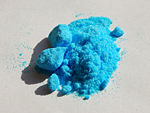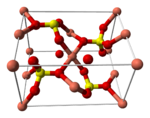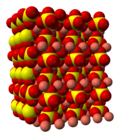Copper(II) sulfate
2008/9 Schools Wikipedia Selection. Related subjects: Chemical compounds
| Copper(II) sulfate | |
|---|---|
 |
|
 |
|
 |
|
 |
|
| IUPAC name | Copper(II) sulfate pentahydrate |
| Other names | Copper(II) sulfate Copper(II)sulfate Cupric sulfate Blue vitriol Bluestone Chalcanthite |
| Identifiers | |
| CAS number | [7758-98-7] |
| EINECS number | |
| RTECS number | GL8800000 |
| Properties | |
| Molecular formula | CuSO4·5H2O (pentahydrate) CuSO4 (anhydrous) |
| Molar mass | 249.684 g/mol (pentahydrate) 159.608 g/mol (anhydrous) |
| Appearance | blue crystalline solid (pentahydrate) gray-white powder (anhydrous) |
| Melting point |
110 °C (− 4H2O) |
| Solubility in water | 31.6 g/100 ml (0 °C) |
| Structure | |
| Crystal structure | Triclinic |
| Coordination geometry |
Octahedral |
| Thermochemistry | |
| Standard molar entropy S |
109.05 J.K−1.mol−1 |
| Hazards | |
| EU classification | Harmful (Xn) Dangerous for the environment (N) |
| NFPA 704 | |
| Flash point | non flammable |
| Related compounds | |
| Other cations | Nickel(II) sulfate Zinc sulfate |
| Except where noted otherwise, data are given for materials in their standard state (at 25 °C, 100 kPa) Infobox disclaimer and references |
|
Copper(II) sulfate is the chemical compound with the formula CuSO4. This salt exists as a series of compounds that differ in their degree of hydration. The anhydrous form is a pale green or gray-white powder, whereas the pentahydrate, the most commonly encountered salt, is bright blue. This hydrated copper sulfate occurs in nature as the mineral called chalcanthite. Archaic names for copper(II) sulfate are "blue vitriol" and "bluestone".
Preparation
Since it is available commercially, a copper sulfate is usually purchased, not prepared in the laboratory. It can be made by the action of sulfuric acid on a variety of copper(II) compounds, for example copper(II) oxide. Copper(II) sulfate pentahydrate decomposes before melting, losing four water molecules at 110 °C and all five at 150 °C. At 650 °C, copper(II) sulfate decomposes into copper(II) oxide (CuO) and sulfur trioxide (SO3). When heated in an open flame the crystals are dehydrated and turn grayish-white.
Uses
As an herbicide, fungicide, pesticide
Copper sulfate pentahydrate is a fungicide. Mixed with lime it is called Bordeaux mixture to control fungus on grapes, melons and other berries, another application is Cheshunt compound, a mixture of copper sulfate and ammonium carbonate used in horticulture to prevent damping off in seedlings. Its use as an herbicide is not agricultural, but instead for control of invasive exotic aquatic plants and the roots of other invasive plants near various pipes that contain water. A dilute solution of copper sulfate is used to treat aquarium fish of various parasitic infections, and is also used to remove snails from aquariums. However, as the copper ions are also highly toxic to the fish, care must be taken with the dosage. Most species of algae can be controlled with very low concentrations of copper sulfate. Copper sulfate inhibits growth of bacteria such as E. coli.
Analytical reagent
Several chemical tests utilize copper sulfate. It is used in Fehling's solution and Benedict's solution to test for reducing sugars, which reduce the soluble blue copper(II) sulfate to insoluble red copper(I) oxide. Copper(II) sulfate is also used in the Biuret reagent to test for proteins.
Copper sulfate is also used to test blood for anaemia. The blood is tested by dropping it into a solution of copper sulfate of known specific gravity — blood which contains sufficient hemoglobin sinks rapidly due to its density, whereas blood which does not, floats or sinks slowly.
In a flame test, its copper ions emit a deep blue-green light, much more blue than the flame test for barium.
Organic synthesis
Copper sulfate is employed in organic synthesis. The anhydrous salt catalyses the trans acetalization in organic synthesis. The hydrated salt reacts with potassium permanganate to give an oxidant for the conversion of primary alcohols.
Chemistry education
Copper sulfate is a commonly included chemical in children's chemistry sets and is often used to grow crystals in schools and in copper plating experiments. Due to its toxicity, it is not recommended for small children. Copper sulfate is often used to demonstrate an exothermic reaction, in which steel wool or magnesium ribbon is placed in an aqueous solution of CuSO4. It is used in school chemistry courses to demonstrate the principle of mineral hydration. The pentahydrate form, which is blue, is heated, turning the copper sulfate into the anhydrous form which is white, while the water that was present in the pentahydrate form evaporates. When water is then added to the anhydrous compound, it turns back into the pentahydrate form, regaining its blue colour.
In an illustration of a "single metal replacement reaction," iron is submerged in a solution of copper sulfate. Upon standing, iron dissolves and copper precipitates.
- Fe + CuSO4 → FeSO4 + Cu
The copper can also be electroplated to the iron.
Other uses
Other applications include hair dyes, coloring glass, processing of leather and textiles and in pyrotechnics as a green colorant.
